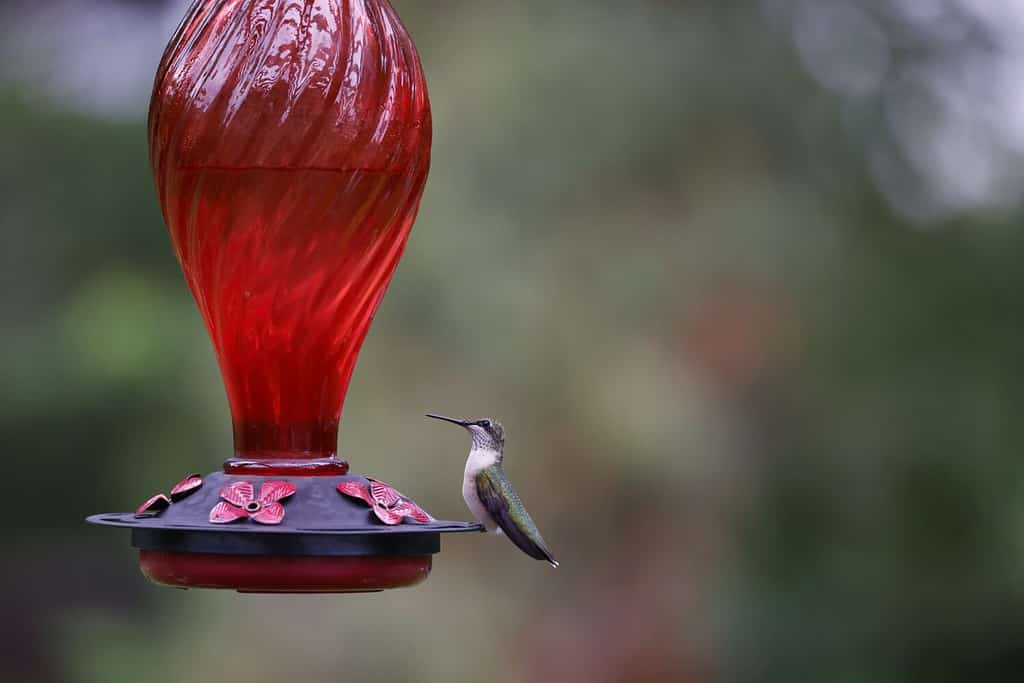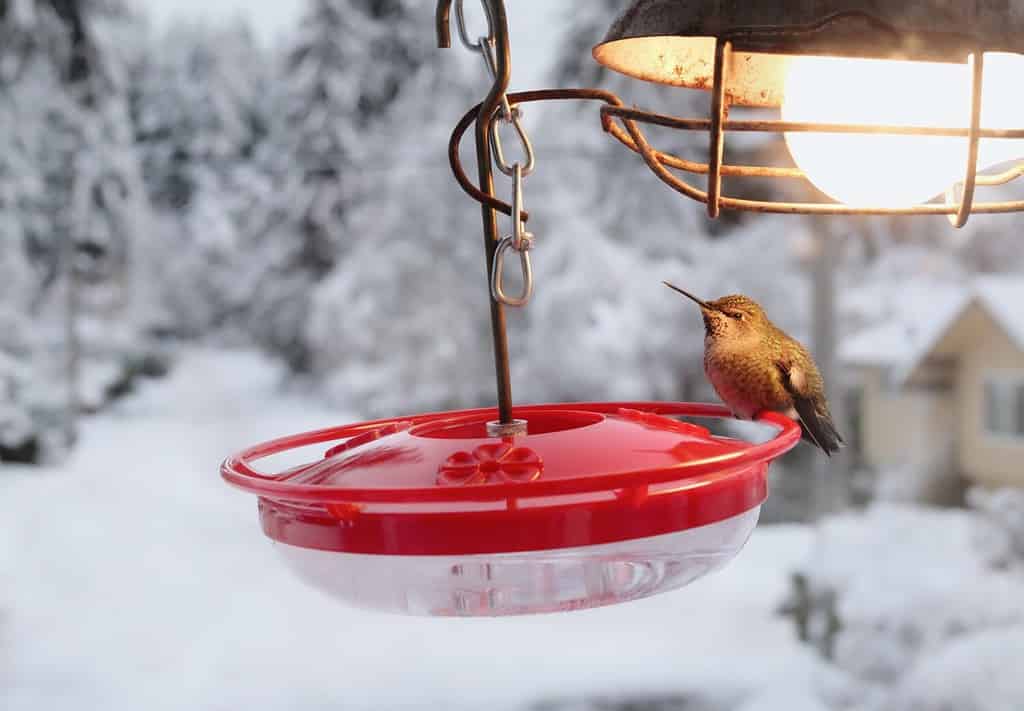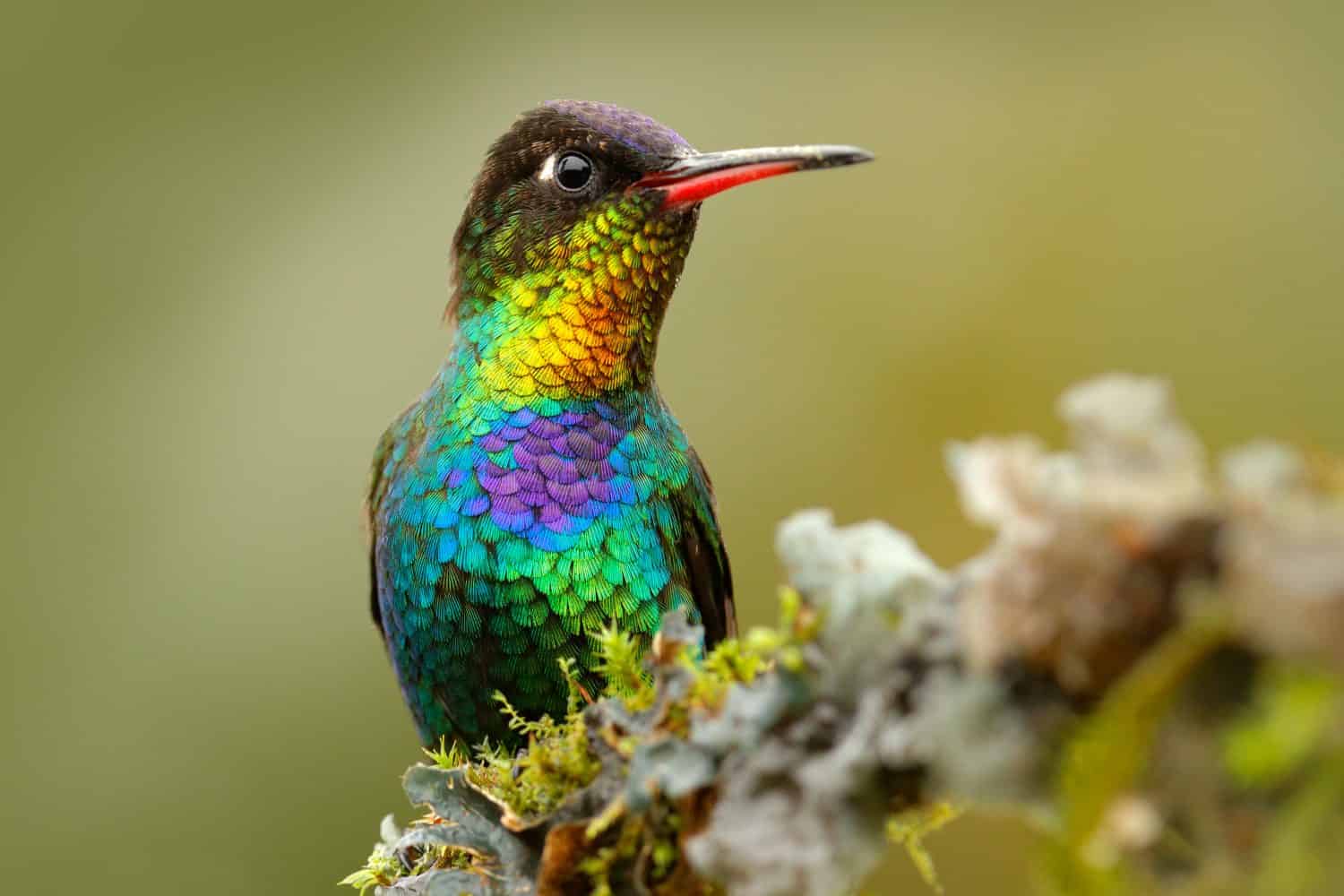What do hummingbirds eat in the winter? Unlike creatures that alter their diets with the shifting seasons, most hummingbirds maintain a fairly consistent diet throughout the year. These tiny aviators have a voracious appetite for nectar. They rely on this liquid gold throughout the lush bloom of summer and the more modest blossoms of winter. Hummingbirds have long, slender bills and extendable, tube-like tongues that allow them to extract nectar from flowers. In addition to nectar, hummingbirds also consume small insects and spiders for protein. Whether amidst the vibrant flora of their breeding grounds or the subtropical landscapes of their winter retreats, hummingbirds demonstrate that the sweetness of nectar knows no seasonal boundaries. Continue reading to learn more about how these hardy little birds survive in winter.

Hummingbirds have long, slender bills and extendable tongues that allow them to extract nectar.
©Chelsea Sampson/Shutterstock.com
What is a Hummingbird?
A hummingbird is a small, colorful bird belonging to the family Trochilidae. These remarkable birds are exceptionally small, astonishingly agile, and conspicuously colorful. Hummingbirds live in the Americas, from Alaska to Tierra del Fuego. The greatest diversity of species is concentrated in the tropics. Most hummingbirds are from 2 to 8 inches (5 to 20 cm) long. Hummingbirds have extraordinary flying abilities. They can hover in mid-air and fly backward! These capabilities allow them to feed on nectar from flowers with precision. Hummingbirds have an incredibly high metabolism and must consume large amounts of food, often feeding multiple times per hour. Hummingbirds display a dazzling array of colors on their feathers, which can appear iridescent and change hue depending on the light. While not all hummingbirds migrate, some species undertake long journeys, traveling thousands of miles between their breeding and wintering grounds.

Hummingbirds display a dazzling array of colors, which appear iridescent and change hue with the light.
©Ondrej Prosicky/Shutterstock.com
Nectar Plus
Hummingbirds feed on nectar from flowers. Nectar serves as their principal source of energy. However, in the winter when flowers are scarce, they depend on additional food sources as well. Although hummers supplement their diet with them throughout the year, in the colder months, hummingbirds increase their intake of insects and spiders for added protein and energy stores. Some hummingbird species drink tree sap or utilize sap wells created by other birds, like woodpeckers. This alternative food source helps them sustain their energy levels when nectar is not readily available. Ruby-throated hummingbirds migrate long distances to find suitable food sources, adjusting their diets accordingly to ensure their survival during the winter months.

Ruby-throated hummingbirds migrate long distances to find suitable food sources.
©Steve Byland/ via Getty Images
Hyperphagia
Ruby-throated Hummingbirds pack on extra weight before their migratory journey. To prepare for the arduous migration across the Gulf of Mexico, these hummingbirds undergo a pre-migratory feeding frenzy that is called hyperphagia. Hyperphagia involves an increased intake of food to build up fat reserves, providing the necessary energy for the long-distance flight.
During this phase, which typically occurs in late summer and early fall, ruby-throated hummingbirds consume astounding amounts of nectar from flowers and sugar water from feeders. This heightened feeding helps them store energy in the form of fat, which serves as a crucial fuel source during their non-stop flight across the gulf.
The weight gained during hyperphagia accounts for a significant portion of the bird’s overall body weight. Some estimates suggest that hummingbirds nearly double their body weight in preparation for migration. This extra weight provides the energy needed for sustained flight over extended distances, ensuring their successful journey to wintering grounds in Central America and Mexico. Once they arrive at their destination, they gradually use up these fat reserves while foraging for food in their winter habitats.

During the cold, a well-maintained feeder with sugar water becomes a hummingbird’s sustenance.
©Randall Vermillion/Shutterstock.com
This amazing bird bath is equipped with a heating element and a thermostatic controller, ensuring a warm haven for birds all winter while saving energy; its innovative design features a deep center, easy-to-grasp border, and an adjustable clamp for easy installation, making it the perfect gift for birds and bird lovers!
Keep Feeding!
In the Deep South of the U.S. and other regions where hummingbirds overwinter, maintaining a hummingbird feeder throughout the winter is a vital act of support for these hardy little birds. Though their appearance might fool you into thinking that these tiny flyers are physically fragile, many species can weather a few days of below-freezing temperatures. However, as natural floral resources diminish in the colder months, a well-maintained feeder is a beacon of sustenance for these tiny wonders. Providing a consistent and accessible food source ensures that these jewel-toned birds can easily replenish their energy reserves, especially during periods when nature’s nectar is scarce. So, as the mercury drops and flowers fade, let the hummingbird feeder stand as a symbol of hospitality, extending a warm welcome to these tireless aviators in need of a nutritional boost.

Adding a light or heat source near a feeder can keep it from freezing on the coldest days.
©sophiecat/Shutterstock.com
Five Fun Hummingbird Facts
- Hummingbirds are solitary migraters. They do not migrate in flocks!
- Hummingbird nests are about the size of a walnut and their eggs look like white jelly beans!
- After consuming a spider, a hummingbird is likely to use its web as a soft lining for its nest.
- The calliope hummingbird is the smallest hummingbird found in the U.S. They are approximately 3 inches (7.62 cm) long and weigh less than 0.10 ounces (2.83 g).
- Though only 15 species of hummingbirds live in the U.S., there are over 300 separate species of hummingbirds throughout the Americas. No hummingbirds are indigenous to Europe or Asia.
Thank you for reading! Have some feedback for us? Contact the AZ Animals editorial team.









